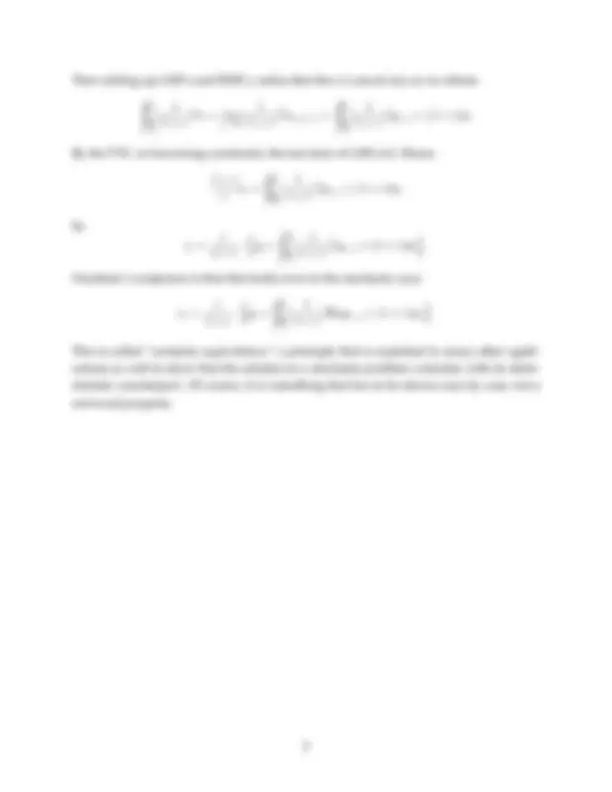



Study with the several resources on Docsity

Earn points by helping other students or get them with a premium plan


Prepare for your exams
Study with the several resources on Docsity

Earn points to download
Earn points by helping other students or get them with a premium plan
Community
Ask the community for help and clear up your study doubts
Discover the best universities in your country according to Docsity users
Free resources
Download our free guides on studying techniques, anxiety management strategies, and thesis advice from Docsity tutors
The derivation of the pih (per capita income-consumption) formula in the context of the certainty equivalence principle. The author, sang yoon (tim) lee, discusses the individual problem, the first-order conditions, and the assumption of β(1+r) = 1 leading to the result that the marginal utility function is the same for all time periods. The document also mentions friedman's conjecture, which suggests this holds true even in the stochastic case.
Typology: Study notes
1 / 2

This page cannot be seen from the preview
Don't miss anything!


Solve the deterministic individual problem
max {ct,at+ 1 }
∞
t= 0
β tu(ct)
s.t. ct + at+ 1 = yt + ( 1 + r)at ∀t
F.O.C.’s are
ct : u′(ct) = λ t at+ 1 : λ t = β ( 1 + r) λ t+ 1
Assuming β ( 1 + r) = 1 , we obtain
u′(ct) = u′(ct+ 1 ).
Hence if u(·) is strictly concave, ct+j = ct for all j. Then writing out the budget constraints,
ct + at+ 1 = yt + ( 1 + r)at ct + at+ 2 = yt+ 1 + ( 1 + r)at+ 1 ct + at+ 3 = yt+ 2 + ( 1 + r)at+ 2 ct + at+ 4 = yt+ 3 + ( 1 + r)at+ 3 · · ·
Multiply iteratively by (^11) +r to get
ct + at+ 1 = yt + ( 1 + r)at 1 1 + r ct +
1 + r at+ 2 =
1 + r yt+ 1 + at+ 1
(
1 + r )^2 ct + (
1 + r )^2 at+ 3 = (
1 + r )^2 yt+ 2 + (
1 + r )at+ 2
(
1 + r )^3 ct + (
1 + r )^3 at+ 4 = (
1 + r )^3 yt+ 3 + (
1 + r )^2 at+ 3 · · ·
1
Then adding up LHS’s and RHS’s, notice that the a’s cancel out, so we obtain
∞ ∑ j= 0
1 + r )jct + lim J→∞
1 + r )J^ at+J+ 1 =
∞ ∑ j= 0
1 + r )jyt+j + ( 1 + r)at
By the TVC or borrowing constraint, the last term of LHS is 0. Hence
1 + r r ct =
∞ ∑ j= 0
1 + r )jyt+j + ( 1 + r)at
So
ct = r 1 + r
yt +
∞ ∑ j= 1
1 + r )jyt+j + ( 1 + r)at
Friedman’s conjecture is that this holds even in the stochastic case:
ct =
r 1 + r
yt +
∞ ∑ j= 1
1 + r )j E tyt+j + ( 1 + r)at
This is called ”certainty equivalence,” a principle that is exploited in many other appli- cations as well to show that the solution to a stochastic problem coincides with its deter- ministic counterpart. Of course, it is something that has to be shown case by case, not a
universal property.